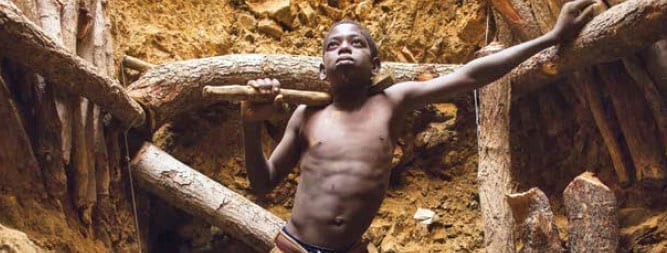Karim Sawadogo is young enough to count his age on his hands, but instead he uses them to hack away at the dry, yellow earth in the hazardous mine shafts where he works in Burkina Faso. He has a few memories of what it’s like to be a child in school or at play. “My dream,” he says, “is to make enough money so I don’t have to do this anymore.”
Sawadogo is among 168 million child laborers around the world, 6 million of whom are estimated to toil in forced labor, according to the U.S. Department of Labor’s new report, “2014 Findings on the Worst Forms of Child Labor.” Some 85 million child laborers are engaged in hazardous work, such as digging gold mines and working in agricultural fields sprayed with toxic pesticides, the report states, citing the International Labor Organization (ILO).
Uzbekistan Retains Bottom Rank for Child Labor
Released yesterday, the report measures the commitment and progress made by governments to eliminate the worst forms of child labor—slavery or trafficked labor, bonded and forced labor, exploitive labor, hazardous work, commercial sexual exploitation and involvement in illicit economies. It ranks 140 countries on their progress since the 2013 report was released last October, from “No Advancement” to “Significant Advancement.” The rankings are based on assessments of meaningful efforts made my governments in the areas of laws and regulation, enforcement, coordination, government policies, and social programs.
The 2014 report ranks 13 countries as showing “Significant Advancement,” including seven in Latin America, four in Africa and two in Asia. Madagascar, Paraguay and Thailand increased their assessment level from “Moderate” in 2013 to “Significant” in 2014. Eritrea, South Sudan and Uzbekistan continue to rank at the bottom of assessed countries because of what the report cites as government complicity in forced child labor.
Sub-Saharan Africa again is the region with the highest incidence of child labor. An estimated 59 million children ages 5–17 are engaged in child labor, or more than one in five children in the region. Nearly 29 million of these child laborers are engaged in hazardous work.
Children Bear the Brunt of Trauma from World Crises
The report reflects on the call to action by 2014 Nobel Laureate and long-time Solidarity Center ally Kailash Satyarthi. “Let’s walk together. In the pursuit of global progress, not a single person should be left out or left behind in any corner of the world, from East to West, from South to North.”
Other notable findings from the report include:
- The Ebola outbreak in West Africa affected 5 million children, some of whom turned to work to support themselves or their families during the crisis.
- An estimated 1 million children were killed, injured, kept out of school, or trafficked as a result of the massive April 2015 earthquake in Nepal.
- Approximately 75 percent of school-aged Syrian refugees in Turkey were not enrolled in schools, making them vulnerable to forced labor and exploitive work.
The State Department this year released an accompanying app, Sweat & Toil: Child Labor, Forced Labor, and Human Trafficking around the World. Users can access a comprehensive database on child labor, searchable by country, goods, or exploitation types. “This report and the new mobile app are intended as practical tools,” says Deputy Secretary of Labor Christopher Lu, “to identify the problem and help governments around the world firm up the foundations of such protections, so that children don’t fall through the cracks.”

